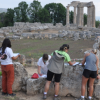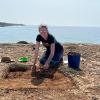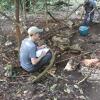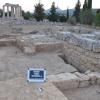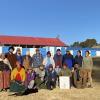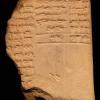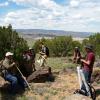Pompeii Artifact Life History Project 2023
For its ninth field season the Pompeii Artifact Life History Project advance its research on the residential properties in Insula (block) I.11 at Pompeii on various fronts. The team completed its evaluation of the portable artifacts and furniture components from the Casa della Venere in Bikini (I.11.6.7) and the unnamed bar/residence at I.11.1.2 stored at the Casa di Bacco storage facility.
Excavation and Conservation of the Early Christian Basilica, Sanctuary of Zeus, Ancient Nemea
The multi-year project of the Nemea Center for Classical Archaeology (DAGRS), the Excavation and Conservation of the Early Christian Basilica, at the Sanctuary of Zeus in Ancient Nemea, Greece, continued in 2023. The center and east ends of the 5thc. CE building were investigated including the nave, aisles, and apse, had been excavated in the 1920s and 1960s. We recorded all of the walls and individual blocks by drawing, photographing, and 3D scanning.
Ancient Seafaring Explorers of Cyprus: Coastal Cliffhangers of the Epipalaeolithic
The recent recognition of Late Epipalaeolithic sites on the Mediterranean island of Cyprus moves the date of early explorers to the island back at least 3000 years, changing our preconceptions about the nature of these first settling communities. Evidence at these early sites suggests that people were bringing plants and animals with them from the mainland (Simmons 1999), creating a sense of home in an unfamiliar landscape.
City life at Classic Maya Palenque, Mexico
Summer 2022 saw the long-delayed start of the NEH-funded project, "City life at Classic Maya Palenque, Mexico", a collaboration between UC Berkeley Professor Rosemary A. Joyce, Universidad Autonoma de México Professor Rodrigo Liendo, UNLV Assistant Professor Lisa Johnson, and Sapienza University of Roma Marie Curie Fellow Arianna Campiani. The team began excavations using fine-grained methodologies to explore household life in the residential sector of this World Heritage Site, the first systematic effort to understand urban organization and growth there.
Excavation and Conservation of the Early Christian Basilica, Sanctuary of Zeus, Ancient Nemea
The multi-year project of the Nemea Center for Classical Archaeology (DAGRS), the Excavation and Conservation of the Early Christian Basilica, at the Sanctuary of Zeus in Ancient Nemea, Greece, began in 2022. The west end of the 5thc. CE building was investigated including the
Reconstructing Animal, Plant, and Landscape Management Processes at the Onset of Food Production in the Lake Titicaca Basin
The Taraco Archaeological Project completed excavations during the summer of 2022 at the Formative site of Chiripa on the shores of Lake Titicaca. The focus was on early occupation seeking early farming evidence. They encountered these levels under historic hacienda deposits in four units. We had a great open day where all of the school children visited the laboratory and excavations.
Ancient Animal Vocabulary
Mesopotamian lexical lists consist of lists of words and lists of signs. Lists of words are often thematically organized, such as a list of birds, or a list of professions. Lists of signs provide each cuneiform sign with pronunciation glosses. Word lists and sign lists belonged to the staple of scribal education. Large numbers of school texts with extracts from lexical lists have been found at almost all sites where cuneiform texts have been unearthed.
Community-Accountable Archaeology with Community Partners
This field season included collaboration with and within the research agendas outlined by the Merced Board at Abiquiú, the descendants and land owners of the main plaza at Conejos CO, the Pueblo of Picuris, NM and with the help of a small crew of experienced excavators, analysts, and local community leaders.The Merced del Pueblo de Abiquiu Community Board has identified several excavation-based research opportunities for their community regarding the first use dates of some of their ancestral agricultural fields, plazas, and acequias and requested that we report to them during their annual
Residential Mobility, Food Diversity and Landscape Practice at the Goshono Site, Iwate Prefecture
Together with two Berkeley graduate students and one undergraduate apprentice, I conducted field and laboratory research in Japan in summer 2020 1) to analyze floral remains obtained from the Middle Jomon Goshono site, Ichinohe Town, Iwate Prefecture, and 2) to process additional soil samples for further analysis. At the laboratory of the Research Institute for Humanity and Nature in Kyoto, we floated soil samples that were previously collected from several pit-dwellings within the site, and sorted both the light and heavy fractions with a guidance from Dr. Yumiko Ito of Aomori Prefecture.








